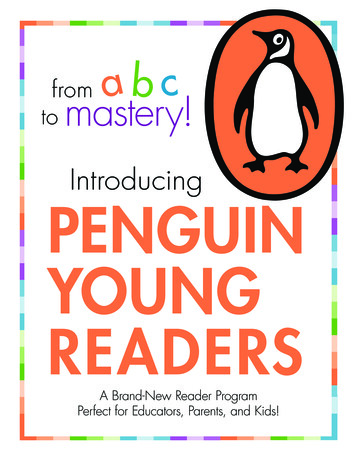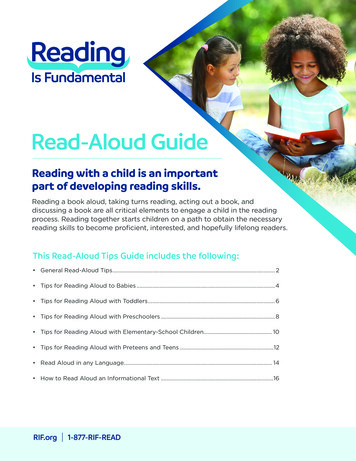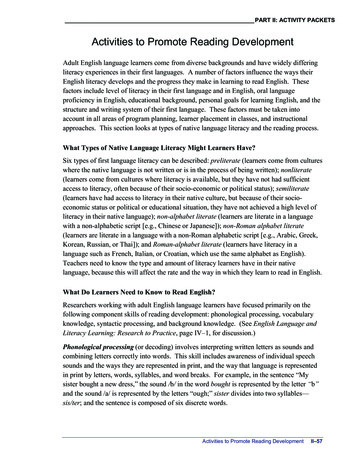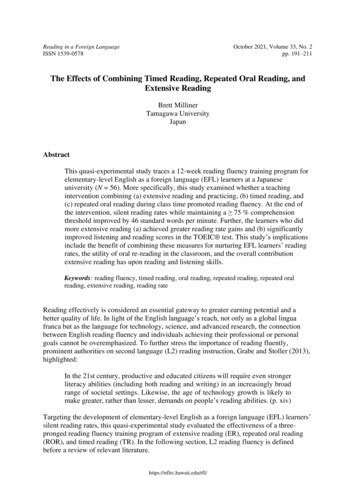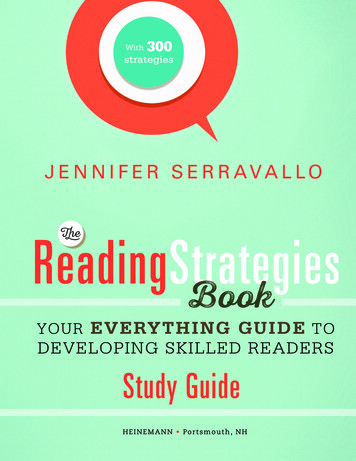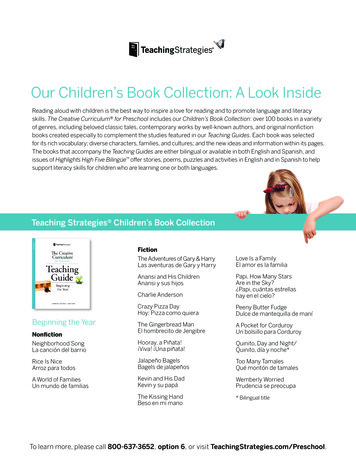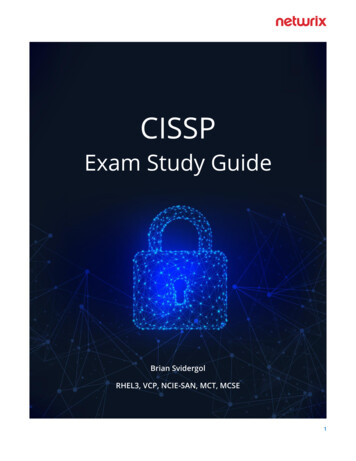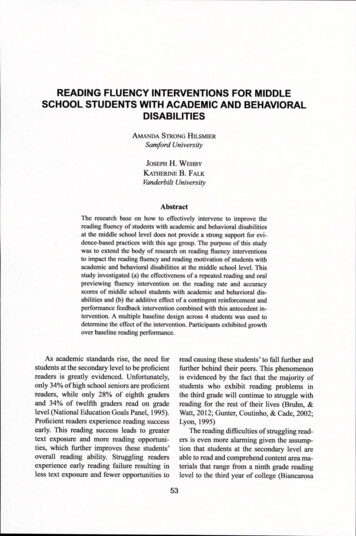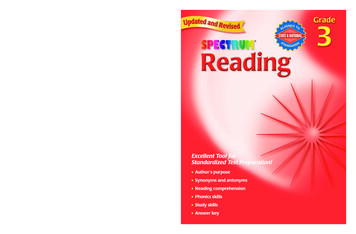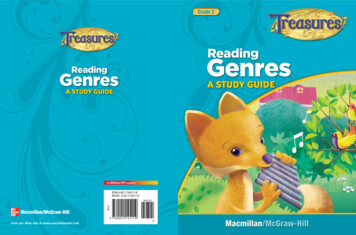
Transcription
Grade 2ReadingGenresReadingGenresA STUDY GUIDEA STUDY GUIDE978-0-02-114511-9MHID: 0-02-114511-399701EAN9 780021 145119Visit our Web site at www.macmillanmh.com2Macmillan/McGraw-Hill
Grade 2ReadingGenresA STUDY GUIDE
APublished by Macmillan/McGraw-Hill, of McGraw-Hill Education, a division of The McGraw-Hill Companies,Inc., Two Penn Plaza, New York, New York 10121.Copyright by The McGraw-Hill Companies, Inc. All rights reserved. The contents, or parts thereof, may bereproduced in print form for non-profit educational use with Treasures, provided such reproductions bearcopyright notice, but may not be reproduced in any form for any other purpose without the prior writtenconsent of The McGraw-Hill Companies, Inc., including, but not limited to, network storage or transmission,or broadcast for distance learning.Printed in the United States of America1 2 3 4 5 6 7 8 9 ROV 14 13 12 11 10
ContentsGenre StudiesPlaysUnit 1:Fables, Legends, Myths . . . . . . . . . . . . . . 1Contents . . . . . . . . . . . . . . . . . . . . . . . . . . . . 37Introduction . . . . . . . . . . . . . . . . . . . . . . . . 38The Tree and the Reed . . . . . . . . . . . . . . . . . 2The Legend of the Bluebonnet . . . . . . . . . . . 3The Midas Touch . . . . . . . . . . . . . . . . . . . . . . 5Genre Activities . . . . . . . . . . . . . . . . . . . . . . . 6Room for More (for Unit 1). . . . . . . . . . . . . . . . . . . . 40The Secret Song (for Unit 2) . . . . . . . . . . . . . . . . . 47I’ll Be the Dragon! (for Unit 3) . . . . . . . . . . . . . . . . 48A Whale of a Story (for Unit 4) . . . . . . . . . . . . . . . 61The Search for the Magic Lake(for Unit 5). . . . . . . . . . . . . . . . . . . . . . . . . . . . . . . . . . . 74Mother Goose to the Rescue (for Unit 6). . . . 89Unit 2:Folktales. . . . . . . . . . . . . . . . . . . . . . . . . . . . . 7How the MockingbirdBecame the Best Singer . . . . . . . . . . . . . . 8A Birthday Party for Rabbit . . . . . . . . . . . . . 10Genre Activities . . . . . . . . . . . . . . . . . . . . . . 12Unit 3:Fiction and Nonfiction . . . . . . . . . . . . . . . 13A Ride to the Refuge . . . . . . . . . . . . . . . . . . 14A Home for Whooping Cranes . . . . . . . . . . 16Genre Activities . . . . . . . . . . . . . . . . . . . . . . 18Unit 4:Poetry . . . . . . . . . . . . . . . . . . . . . . . . . . . . . . 19The Mockingbird . . . . . . . . . . . . . . . . . . . . . 20Lazy Lizard . . . . . . . . . . . . . . . . . . . . . . . . . . 21The Rio Grande . . . . . . . . . . . . . . . . . . . . . . 22Get on the Bus!. . . . . . . . . . . . . . . . . . . . . . . 23Genre Activities . . . . . . . . . . . . . . . . . . . . . . 24 Macmillan/McGraw-HillUnit 5:Procedural Text . . . . . . . . . . . . . . . . . . . . . 25How to Make a Book Cover . . . . . . . . . . . . . 26Genre Activities . . . . . . . . . . . . . . . . . . . . . . 30Unit 6:Fiction . . . . . . . . . . . . . . . . . . . . . . . . . . . . . . 31A Day at the Cattle Ranch . . . . . . . . . . . . . . 32The Rescue . . . . . . . . . . . . . . . . . . . . . . . . . 34Genre Activities . . . . . . . . . . . . . . . . . . . . . . 36Drama ActivitiesDrama Activities (for Unit 1) . . . . . . . . . . . . . . . . . 101Drama Activities (for Unit 2) . . . . . . . . . . . . . . . . . 103Drama Activities (for Unit 3) . . . . . . . . . . . . . . . . . 105Drama Activities (for Unit 4) . . . . . . . . . . . . . . . . . 107Drama Activities (for Unit 5) . . . . . . . . . . . . . . . . . 109Drama Activities (for Unit 6) . . . . . . . . . . . . . . . . . .111
Genre StudyFables, Legends,MythsReading Fables,Legends, and MythsFables, legends, and myths are three kinds ofstories. Many of these stories are very old. Theyare alike in some ways. Each story has a theme,or main idea. The theme may be a lesson.Sometimes the lesson is called a moral. Macmillan/McGraw-Hill A fable is a short story that teaches alesson. Often a fable ends with a moral. Themoral is a sentence that explains the lesson.Many fables are about animals. The animalsact as though they are people. The animalsspeak to one another and sometimes to people. A legend is a story from long ago. A legendmay tell about a person who is made up. Itmay tell about a real person from the past.But all legends have details that are made up.Legends may be serious or funny. A myth is a story that explains something.A myth may tell how the world began or whythere are stars. Some myths tell about gods orgoddesses.1
Genre StudyFables, Legends,MythsThe Tree and the ReedA tall tree grew on the bank of a river. The treewas straight and strong. A reed grew next to it. Areed is a plant that is like tall grass. The reed bentwhen the wind blew.“Why do you bend so much?” the tree asked.“Look at me. I am proud of my size. I stand upstraight. You should do the same.”“I like being this way,” said the reed. “I am notas big as you are, but I am happy.” Macmillan/McGraw-HillThe next day, a strong wind blew against thetree. The tree tried to keep standing, but its rootscame out of the ground. The proud tree fell over.The wind blew against the reed, too. But the reedbent until the wind stopped. Being the biggest andstrongest is not always best.2
Genre StudySet a purpose for reading. What do you wantto find out about the legend of Bluebonnet?Fables, Legends,MythsThe Legend ofthe BluebonnetYears ago, there was a long time of dry weatherin Texas. Ponds and rivers dried up. The animalshad nothing to drink, and the plants could notgrow. The people were hungry because they hadlittle food. Many became sick. Some even died. Macmillan/McGraw-HillThe people hoped and prayed for rain. Theyplayed music and sang to the Great Spirit. Then onewise man told them what they must do. He saidthat each one must give up something special.One girl had lost her whole family. Her namewas She-Who-Is-Alone. She had only one thingthat she cared about. Her grandmother had madeher a special doll. Grandmother had painted thedoll’s face and put bluebird feathers on its head.3
Genre StudyFables, Legends,MythsShe-Who-Is-Alone knew that she must help herpeople. She must give up something special. Thatnight, She-Who-Is-Alone threw her doll into thefire. She asked the Great Spirit to send rain so thather people could live. After the fire burned out, shepicked up some ashes. She-Who-Is-Alone threwthem into the wind. Then she went home to sleep.In the morning, She-Who-Is-Alone saw blueflowers everywhere. They covered the hills as far asshe could see. That day the rain fell, and there wasplenty of water. The people were thankful. Macmillan/McGraw-HillThose flowers are now called bluebonnets. Todaythe bluebonnet is the state flower of Texas. Theblue flowers cover the land every spring. Peoplewho see them think of She-Who-Is-Alone and hergreat gift.4
Genre StudyFables, Legends,MythsThe Midas TouchAn old myth tells about King Midas. He lived inGreece. Midas helped a man who was lost. The lostman was a good friend of a Greek god.The god gave Midas one wish for helping hisfriend. Midas wanted to be very rich. He said, “Iwish that everything I touch would turn to gold.”Then Midas touched a stick. It turned to gold!Later, Midas sat down to eat. As soon as hetouched the food, it turned to gold! Midas couldnot eat gold! Macmillan/McGraw-HillMidas called out to the god, “Please take awaythe wish!” The god told Midas to wash in the river.When he did, the sand turned to gold. Now Midascould eat. He was happy without all that gold.5
Genre StudyActivitiesFables, Legends,MythsWhat Is the Lesson?Each story you have read teaches a lesson. The lessonis the theme of the story. In a small group, talk aboutthe answers to these questions.1. What is the moral of the fable of the tree and the reed?2. Is She-Who-Is-Alone selfish or unselfish? How doyou know? Explain how that helps her people.3. What does King Midas learn about gold?4. In what ways are all of these stories alike?The Theme of a Story Macmillan/McGraw-HillOften the lesson is the theme, or main idea, of a story.Talk to a partner about the lesson each story teaches.Work together to write sentences that tell each theme.6For Activity answer keys go towww.macmillanmh.com
Genre StudyFolktaleReadingFolktales A folktale is a made-up story that takesplace long ago. Folktales are told all over theworld. Every culture has these stories to share. People have told folktales many times overmany years. Parents tell them to their children.One day they will tell the stories to their children. Macmillan/McGraw-Hill Like all stories, folktales have characters,settings, and plots. Characters are the people,animals, or things that the story tells about.The setting is the time and place in which thestory happens. The plot is what happens. In many folktales, animals talk. They actthe same way people act. They have problems.They make mistakes. They grow older andwiser. They learn how to live in the world. From time to time, people make up newfolktales. They spread from person to personjust as the old stories did.7
Genre StudySet a purpose for reading. What do you wantto find out about the mockingbird’s singing?FolktaleHow the MockingbirdBecame the Best SingerA young mockingbird had a beautiful voice.She wanted to take singing lessons, but she had nomoney for them.A young cardinal took singing lessons. Her richfather wanted her to sing. But the young cardinaldid not practice. She did not care how she sounded.The cardinal’s father asked the other birds tocome and hear his daughter sing. The youngcardinal was afraid. She could not sing.She asked a woodpecker to help her cut ahole in the tree. The young cardinal asked themockingbird to hide there and sing for her.8 Macmillan/McGraw-HillThe mockingbird hid behind a tree. She watchedthe singing lessons. She learned how to sing.
Genre StudyFolktaleWhen the time came to sing, the youngmockingbird sang. The young cardinal pretendedto sing. The other birds heard a beautiful voice.They all clapped.The father knew that his daughter was notsinging. He found the mockingbird hiding. He toldher to come out.“This is the true singer,” the father said. “Thebeautiful voice belongs to the mockingbird.” Macmillan/McGraw-HillThe other birds asked for more music. Themockingbird sang again. Ever since, mockingbirdshave had beautiful voices. Cardinals never havelearned to sing.9
Genre StudyFolktaleA Birthday Party for RabbitMouse found Squirrel in the forest. “Squirrel,”Mouse called. “Will you help me? I want to havea birthday party for Rabbit.”“Yes,” Squirrel said. “What can I do to help?”They went to Mouse’s home. Squirrel made anacorn cake with berries on top. “What else shouldwe do for the party?” asked Squirrel.“You can draw better than I can,” Mouse said.“Will you make Rabbit a birthday card?”Squirrel folded a piece of paper. He drew redflowers on it. He wrote “Happy Birthday” on it.10 Macmillan/McGraw-Hill“I am not a very good cook,” Mouse said.“Can you make a cake?”
Genre StudyFolktale“Now we must ask our friends to come,” Mousesaid. So Squirrel brought Robin and Frog over. Theysaid, “Oh, Mouse! You did a very good job!”“Thank you,” Mouse said. “I worked very hard.”Then Rabbit came in the door. “Surprise!” theyshouted. “Happy birthday, dear Rabbit!”Mouse gave everyone a piece of cake. Then hegave the card to Rabbit.“Oh, what a pretty card!” she said. “What agood cake! What a nice party! You did a good job,Mouse.” She gave Mouse a big hug.Mouse looked at Squirrel. He thought aboutSquirrel’s help. “Squirrel did the work,” he said. Macmillan/McGraw-Hill“Thank you, Squirrel! You are a good friend!”Rabbit said.11
Genre StudyActivitiesFolktaleWhereDoes ItHappen?TheSame andDifferentBoth stories take place ina forest. Draw two picturesthat show the place whereyour favorite part of eachstory happens. Share yourpictures with a partner.Talk about how the twosettings are different andhow they are alike.Think about what happensin the two stories. Howare the plots of the storiesthe same? How are theydifferent? Talk about youranswers in a small group.Think about the young cardinal and the squirrel inthe folktales. Then fold a sheet of paper in half. Write“Cardinal” on one half and “Squirrel” on the other. Under“Cardinal,” write two ways that Cardinal acted the way aperson would act. Under “Squirrel,” write two ways thatSquirrel acted the way a person would act. Talk aboutyour answers with a partner.12For Activity answer keys go towww.macmillanmh.com Macmillan/McGraw-HillAnimals Act Like People
Genre StudyFiction andNonfictionReading Fictionand Nonfiction Macmillan/McGraw-Hill Fiction is a story with made-up charactersand events. Characters are the people,animals, or things in the story. The setting iswhere a story happens. The plot is the eventsthat happen. Every story has a beginning, amiddle, and an end. Nonfiction gives information and factsabout a topic. Nonfiction tells about realpeople, places, or things. The information isnot made up. The title and the first paragraphusually tell what the text is about. The middlepart tells more about the topic. The lastparagraph summarizes the topic or tells whatthe author thinks is important. Nonfictionselections often have pictures. Captions givemore information about the pictures. As you read, ask literal questions about the text.Then try to figure out the answers to help youunderstand the text better. After you read, discussyour questions and answers with a partner.13
Genre StudyAsk literal questions as you read. Shareyour questions and answers with a partner.Fiction andNonfictionA Ride to the Refuge“We’re almost there,” Dad said. “I see the sign.”He drove into a parking lot and stopped the car.Sara looked through the binoculars. She sawa sign with a map of Texas. An arrow pointed toa spot on the Gulf Coast. The letters looked big.“What does refuge mean?” she asked.“A refuge is a safe place,” Mom said. “This isa safe place for birds called whooping cranes.”14 Macmillan/McGraw-HillMom put her bird book into her pocket. Shehanded Sara a pair of binoculars. “You will seebetter with these,” Mom said.
Genre StudyFiction andNonfictionThey climbed onto a bus with other people.As they rode, Sara saw an alligator by the water!Sara saw small birds in the water. Mom lookedthem up in the bird book. Then everyone lookedthrough their binoculars and saw tall white birds.“There they are!” Mom said. “The whoopingcranes are feeding.”Sara watched one bird walk through the water.It poked at something with its bill. It caught a frog!“We are lucky to see these birds,” Dad said.“Not many of them are left.” Macmillan/McGraw-Hill“I am glad they are safe here,” Sara said.15
Genre StudyAsk literal questions as you read. Shareyour questions and answers with a partner.Fiction andNonfictionA Home forWhooping CranesA marsh is a wet place. Most of the time, water coversthe land. Many kinds of animals live in and around a marsh.One marsh in Texas is a special home for whooping cranes.There are many marshes on the Gulf Coast of Texas.These marshes make perfect homes for whooping cranes.Whooping cranes catch fish and insects. They also eatcrabs, frogs, and clams.Many different animals live in the marsh.16 Macmillan/McGraw-HillA whooping crane is almost five feet tall. It haswhite feathers and a red and black head. Its neck is long,and its wings spread seven feet across.
Genre StudyFiction andNonfictionWhooping cranes are named for the whooping soundsthey make. They sound like loud horns blowing. In springthe birds seem to dance. They call, they leap, and theyflap their wings.In the past, people hunted whooping cranes.People lived on the land where the birds once lived.Now only three groups of these birds are left. Macmillan/McGraw-HillOne group of whooping cranes spends the summerin Canada. The birds spend the winter in a refuge, or safeplace, on the Texas coast. Each year they fly more than2,000 miles each way. A pair, a family, or a small groupmakes the trip together. Few of these great birds are left,but people are working to keep them safe.In spring, whooping cranes seem to dance with one another.17
Genre StudyActivitiesFiction andNonfictionFiction or Nonfiction?Find a partner. Take turns answering these questions.Then write your answers in your Writer’s Notebook.1. Which selection is fiction and which is nonfiction?How do you know?2. Retell the events in the fiction story.3. What is the topic of the nonfiction selection?4. Use text clues to make a connection betweenthe fiction and the nonfiction selections.Write a StoryA made-up story can have a real place as its setting. Think about a place you know of or have been to. Make up a character that might go there. Write a short story about your made-upcharacter at that place. Make sure that your story has a beginning,a middle, and an end. Act out your story in a small group.18For Activity answer keys go towww.macmillanmh.com Macmillan/McGraw-Hill Make up something that the character does.
Genre StudyPoetryReading Poetry Some poems have rhyming words.Rhyming words have the same end sound.For example, way and day are rhyming words.Rhyming words may be used at the end of eachline, in every other line, or in a different pattern. Some poems have repeated words.Repeated words can be used in different placesin a poem. This is called repetition. A rhyming pattern and repetition givea poem rhythm. The rhythmic pattern maybe slow or fast. Macmillan/McGraw-Hill Rhyming words, repetition, and rhythmicpatterns help make an image. An image isa picture in your mind.19
Genre StudyPoetryThe MockingbirdTell me, have you ever heardthe strange call of a mockingbird?Instead of singing just one way,it changes songs throughout the day.It sounds like one bird, then another.A mockingbird could fool its brother!How would you know if you heard one?You could not say, when it was done,“Hello! Are you a mockingbird?”You know it would not say a word. Macmillan/McGraw-HillYou have the answer in its song.It sings so many, and none are wrong!20
Genre StudyPoetryLazy Lizard Macmillan/McGraw-HillLazy lizard, resting in the sun,You sit on the same warm rock all day.What have you seen? What have you done?You never talk, so you will never say.What kinds of thoughts are in your head?Do you mind the people walking by?Do you like using a rock as a bed?Does a sad story make you cry?Some things about lizards I do not know.Where are they from, and where do they go?The thing they like best I know for sure.Lying on a warm rock must be a cure.The nice warm sun will bake awayAll of the troubles of the day.21
Genre StudyPoetryThe Rio GrandeThe river makes a path of blue,Winding here and there.It has so many miles to goBut does not have a care.Branching trees live near it.Thirsty deer drink from it.Moss grows on rocks near it.Swimming fish tickle it.The river licks the land awayWandering here and there.It shapes the earth and cuts the rocksBut never leaves it bare. Macmillan/McGraw-HillOn a sunny day or a starry nightThe Rio Grande is a beautiful sight.22
Genre StudyPoetryGet on the Bus!Walk fast! Run fast! Do not be late.You know the school bus cannot wait.Your friends are saving you a seat.They wave at you and stamp their feet.Soon the bus will roll along.The tires will sing a rolling song. Macmillan/McGraw-HillNow all of you are on your way.You talk and laugh. Last chance to play!When class is over, school is done.You hurry out into the sun.Walk fast! Run fast! Do not be late.You know the school bus cannot wait.23
Genre StudyActivitiesPoetryLook for ItFind a partner. Then answer these questions together.1. Which poems have rhyming words?2. Reread “Lazy Lizard.” What is the patternof rhyming words?3. Which poems have repetition? Point tothe places where the same word appears.4. How do the repeated words give “Get on the Bus!”a fast rhythm? Explain.What Do You See?Form a small group. Read each poem aloud togetherand clap out the rhythm. Then talk about each poem. Where are the rhyming words? Which words are repeated? Macmillan/McGraw-Hill Describe images the poem creates.How do rhyming words, repetition,and rhythm help make them? With your group, write a short poem.Be sure to include sensory details in it.24For Activity answer keys go towww.macmillanmh.com
Genre StudyProcedural TextReadingProcedural Text Procedural text tells you how to make ordo something. A recipe is a procedural text.Other kinds are instructions and rules for games. Procedural texts show a list of materialsthat you need. The materials are tools orsupplies. You need to get all the materials beforeyou begin. Often lists use abbreviations, such as“qt.” for quart. An abbreviation is a shorter wayof spelling something. Macmillan/McGraw-Hill All procedural texts list the steps to follow.The steps tell what to do first and what to do next.Sometimes they are numbered. Sometimes thewriter uses words such as first, next, then, and lastto show the order. Procedural texts often have drawingsor pictures that show what to do. They helpyou complete each step correctly.25
Genre StudySet a purpose for reading. What do youwant to find out about making book covers?Procedural TextHow to Makea Book CoverYou can keep a new booklooking good. A book cover helpskeep a book clean. You can covera book with plain white paperor with brown paper cut froma paper bag.Materials book large sheetof paper scissors tape markers colored pens stickers rubber stampsand inkA book cover can also bea piece of art. After you finishmaking the cover, you can writethe title of the book and thename of the author on it. Thenyou can color your cover. You can add stickersor stamp it.You can decorate itany way you like. Macmillan/McGraw-HillAfter youchoose a book, let’smake a book cover!26
Genre StudyProcedural TextSteps to follow:Step 1 Make sure that the paper is big enough.Open the book, and lay it in the middle ofthe paper. There should be a few inches of papershowing along each edge of the book. If the paperis bigger than that, cut some paper off ofthe edges.Step 2 Leave the open book in the middle ofthe paper. Fold the edge of the paper along the topedge of the book. Run your fingers along the foldto make a crease in the paper. Macmillan/McGraw-HillStep 3 Fold the edge of the paper alongthe bottom edge of the book. Make a creasein the paper along the fold.Step 4 Take thebook off of thepaper. Fold thepaper down flatalong the top crease. Dothe same along the bottomcrease. The folded papershould be the same height asthe book.FOLD UPFOLD UP27
Genre StudyProcedural TextStep 5 Close the book. Lay it near the right endof the paper with the book’s front cover showing.Put the top and bottom edges of the book alongthe folds. Pull the left side of the paper over thebook. Slide the paper so that the book is in themiddle and the edges of the paper are even.Step 6 Fold the left end of the paper underthe front cover of the book. Crease the paper.Slide the book’s front cover into the pocket that ismade by the fold.FRONT COVEROF BOOK Macmillan/McGraw-HillStep 7 Fold theright end ofthe paper insidethe back cover ofthe book. Creasethe paper. Slide thebook’s back coverinto the pocket thatis made by the fold.PAPERBOOK COVER28
Genre StudyProcedural TextStep 8 Open and close the book to make surethat the cover fits tightly. Adjust the folds if youneed to. Tape the paper together along the topand bottom of the folds you made in Steps 6 and 7.Tape could hurt the book, so do not tape the coverto the book.Step 9 Write the title of the book near the top ofthe cover. Add the name of the author below it.Write your name near the bottom of the cover.Use any colors that you like.Use art supplies to decorate the book cover. Ifthe book is a textbook, draw picturesof the subject. If the book is fiction, draw picturesof what happens in the story. Add stickers orstamp the cover. You might tape pictures ontothe cover. Macmillan/McGraw-HillAfter you finish,show the book coverto your friends.Then you can showthem how to maketheir own book covers.29
Genre StudyActivitiesProcedural TextMake an Apple SnackHere is an apple snack that is easy to make. Remember thatabbreviations are shorter ways of spelling things. Make sureyou identify the abbreviations on this page. The abbreviationfor cup is “c.” and for teaspoon is “tsp.” You will needthese ingredients: 1 apple 1 tsp. cinnamon 1 c. of vanilla yogurt nuts or granolaFirst, ask an adult to cut the apple into pieces. Put the applepieces into a bowl. Next, pour the vanilla yogurt over theapples. Then sprinkle the cinnamon over the yogurt and stirit in. Finally, put nuts or granola on top. Now it’s ready to eat!Make a Book CoverReread the steps for making a book cover. Look at each ofthe pictures. Gather the materials you need, and make thebook cover. After you have finished, talk to a partner abouthow the pictures helped you.30For Activity answer keys go towww.macmillanmh.com Macmillan/McGraw-HillExtend What is your favorite snack? Give instructions to apartner on how to make a snack. Be sure to tell each step oraction in the correct sequence.
Genre StudyFictionReading Fiction Fiction is a story with made-up characters.The characters in a story might be people.They might be animals or things that talkand act like people. Fiction is a story with made-up events.The events, or the things that happen, in a storyhave not happened in real life. But the eventsmay be realistic, or seem like things thatreally happen. Macmillan/McGraw-Hill Fiction has a setting. The setting is wherea story happens. The setting can be a realplace, even if what happens there is made up.Sometimes the setting is also made up. A storycan happen in the past, the present, or the future. Fiction has a plot. The plot is what happens ina story. The events of the plot help tell the story.The story has a beginning, middle, and end.31
Genre StudyFictionA Day at the Cattle Ranchby Daniel Long“Rise and shine,” Uncle Ron called. “We haveto get an early start. This afternoon it will betoo hot to work.”Jason jumped out of bed,excited about his visit to hisaunt and uncle’s Texas cattleranch. After a big breakfast,Uncle Ron and Aunt Elenagave Jason a tour of theranch. They rode their horsesthrough a field where a herdof cattle grazed.Jason stared at a hugebrown animal. “Look at thosegiant horns!” he said. “Is that a bull?”“What about the calves?” Jason asked.“Look at this one,” Aunt Elena said. “This calf isonly about one month old. You can see the bumpson its head. They will turn into horns.”32 Macmillan/McGraw-HillUncle Ron laughed. “That’s a mama longhorncow,” he said. “Among longhorn cattle, both cowsand bulls have horns.”
Genre StudyFictionUncle Ron looked over the animals to makesure that they were healthy. He checked the fenceto be sure that it was not broken. Then the threerode toward the creek.Yellow flowers bloomed along the banks ofthe creek. The horses walked along a narrow pathto the water. Jason jumped off his horseto throw stones in the creek. He saw a lineof animal footprints.“Deer come here to drink,” Aunt Elena said.At a bend in the creek, the water formeda small pool. A rope swing hung fromthe branch of a tall tree.“We can swim herelater,” Uncle Ron said.“It’s almost time to eatthe picnic lunch webrought along.” Macmillan/McGraw-Hill“Great!” Jason said.“I want to try outthat swing!”33
Genre StudyFictionThe Rescueby Daniel LongA fierce wind blew over the Texas ranch.Dried round tumbleweed plants rolled acrossthe land. Tom looked up at the sky and saw darkclouds gathering. A storm was on its way.He stopped working and put away the tools he hadbeen using to fix the fence.Thunder growled, andlightning flashed. Rain beganto pour down from the clouds.A hat with a wide brim kept the rain out ofTom’s eyes, but soon his clothes were soaked.He counted again. One calf was missing.That calf was too young to be on its own.It belonged with its mother.34 Macmillan/McGraw-HillTom jumped on his horse tohead for home. He knew thathe had to check on the cattlefirst. He saw the herd faraway and started counting ashe rode near. All of the cowswere in the group, but Tomcould not see all of the calves.
Genre StudyFictionTom rode his horse along the creek.The rushing water roared so loudly that he couldbarely hear. Tom could see clearly only whenlightning flashed. Then he saw that the waterwas rising.Tom saw a path to the water’s edge. The calfmight have been thirsty and wandered off to geta drink. Tom looked carefully along the path.At the bank of the creek, he saw the missing calf.Tom tied his horse to a nearby tree. Rain hadmade the path muddy. Tom slipped a little ashe made his way to the calf. It was not hurt.He picked it up and carried it back along thepath to safety. Macmillan/McGraw-HillBefore long, the calfwas beside its mother.Tom smiled and turnedhis horse toward home.Soon he would be withhis own family, feelingwarm and dry.35
Genre StudyActivitiesFictionAlike or DifferentIn a small group, talk about these questions.1. Did the same author write both stories?How do you know?2. Think about the setting of each story.In what ways are the two settings alike?3. In what ways are the two settings different?4. Think about the plot of each story.In what ways are the two plots alike?5. In what ways are the two plots different?Tell a Story Make up a story that happens in a settingthat you know. The setting might be your school,your neighborhood, or your city. Think of something the character doesto help someone. Decide how to tell what happens in the story. When you are ready, tell your story to a partner.36For Activity answer keys go towww.macmillanmh.com Macmillan/McGraw-Hill Make up a character for the story.It can be a person, an animal, or a thing.
CONTENTSPlaysIntroduction . . . . . . . . . . . . . . . .
Years ago, there was a long time of dry weather in Texas. Ponds and rivers dried up. The animals had nothing to drink, and the plants could not grow. The people were hungry because they had little food. Many became sick. Some even died. The people hoped and prayed for rain.


